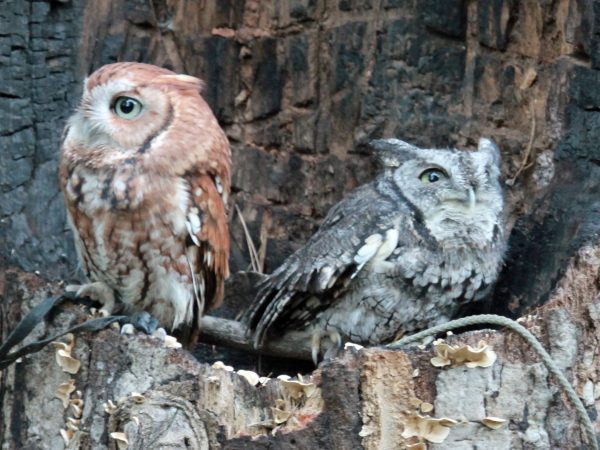A small owl with a big song

If you’re much of a birder and you ever use playbacks to attract a bird, you know there’s one sure way to get a variety of birds to come out. Play the song of an eastern screech owl. Songbirds are one of their favorite prey species, yet those little guys don’t give up without a fight – songbirds are known to mob screech owls to defend their turf and protect their brood.
The eastern screech owl (Megascops asio) is a small owl, roughly 6 to 10 inches long, found in eastern North America from Mexico to Canada. There are two color phases, the gray morph and the rufous morph (more of a reddish-brown color). The red color phase is more common in the southern part of its range, but both are found in the same areas. Gray morphs blend in well with hardwood trees, while red morphs are more camouflaged in pine forests. The rarer brown morph is found only in the southern portion of its range, mostly Florida, and is thought to possibly be a hybrid between gray and rufous morphs.
All screech owls are patterned with complex bands and spots that provide them with excellent camouflage. Western screech owls are close in appearance to eastern screech owls, but have a darker beak. The call of the western screech owl differs from that of the eastern. The call of a screech owl is not actually a screech, but, for the eastern screech owl, more of a trill or whinnying noise – think of a horse on helium – and for the western screech owl a series of “bouncing ball” notes that accelerate near the end.
They live in a variety of habitats including hardwood forests, parks, suburban areas, orchards and fields. Screech owls are most attracted to areas with trees, especially on riparian corridors or near wetlands, and they avoid areas with large expanses of open land. They are more adapted to living in suburban and urban areas than most other owl species. They nest in natural and manmade cavities, and if you have a wood duck box you know they often nest in them. Holes made by pileated woodpeckers and northern flickers are also large enough for a screech owl.
Screech owls are opportunistic predators, eating everything from songbirds to lizards to cicadas to mice, and are even known to fish for trout and occasionally eat carrion. They are nocturnal, though they may be spotted in daytime near their nest. They hunt at dusk and at night, predominantly by watching from a perch then swooping down to attack their prey, and they can catch flying insects in the air.
A lot of other owl species prey on screech owls, including great horned owls and barred owls, and raptors feed on them as well, including red-tailed hawks and coopers hawks. Mortality rates among young screech owls can be as high as 70 percent.
You’re much more likely to hear than see a screech owl, so keep an ear out for their spooky song. I’ve seen only one in the wild during the daytime, but they may be around their nest site perched on a tree branch. Or you could see one peeking from a nest cavity in a tree. They are beautiful little birds.